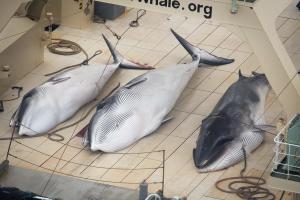Japan dolphin slaughter draws unusual US rebuke
The annual hunt in Taiji began today. US Ambassador Caroline Kennedy tweeted her dismay over the 'inhumaneness' of 'drive hunt killing,' drawing quick response from Japanese officials.

Fishermen in Japan have begun slaughtering dozens of bottlenose dolphins, ignoring
protesters’ calls
The annual hunt in Taiji, a picturesque whaling town on the Pacific coast, began early Tuesday morning, according to activists from the Sea Shepherd marine conservation group who are monitoring the fishermen.
As
many as 250 dolphins were herded into a secluded cove late last week;
some were selected for sale to aquariums and marine parks, but by the
end of Tuesday, about 40 dolphins had been killed in the cull, which is
conducted mostly out of view beneath tarpaulin covers. More than 100
remaining mammals – mainly young calves – were driven back out to sea.
The hunt has been in the international spotlight since the 2009 release of "The Cove," an Oscar-winning documentary about the town’s dolphin-hunting tradition and attempts to end it.
This year’s slaughter attracted more attention than usual after US Ambassador Caroline Kennedy
publicly criticized the methods used in the hunt. Ms. Kennedy, who only
recently took up her post, was seen as an inexperienced but popular
appointment because of her family background and close ties to President
Barack Obama. Her willingness to enter the fray over issues that have
attracted mainly private criticism from Washington – as well as the
embassy's recent statement criticizing Prime Minister Shinzo Abe’s visit
last month to a controversial war shrine – has forced senior Japanese
officials on the defensive.
'INHUMANENESS'
In
a tweet sent out at the weekend, Kennedy wrote: “Deeply concerned by
inhumaneness of drive hunt dolphin killing. USG [US government] opposes
drive hunt fisheries.”
Kennedy
was referring to the practice, long used in Taiji, of herding pods of
dolphins into shallow water, where the exhausted animals are left for up
to a few days before being killed.
Hunters kill the mammals by
driving metal poles through their spinal cords – a practice they say is
more humane and reduces bleeding – but activists claim it can take
20-30 minutes for them to die.
Kennedy
may get to see the practice firsthand following reports that fishermen
in Taiji, who often refuse to talk to reporters, would welcome her.
“I
want her to come and visit so that she can understand how we make a
living from it," a local fisheries official told Agence France-Presse on
condition of anonymity. "Many fishermen make a living from the hunting,
and many others also earn their living by working at food processing
factories.”
Kennedy's
criticism of the visit to Yasukuni Shrine, which Japan's neighbors argue
is a symbol of its unrepentant aggression during World War II, prompted
Japan’s foreign minister to call her while she was on vacation to
explain Tokyo’s position.
Chief Cabinet Secretary Yoshihide Suga
pointed out that the 1986 ban on commercial whaling did not apply to
dolphins and other small cetaceans, adding that the mammals were not
endangered.
"Dolphin fishing
is one of Japan's traditional fishing techniques and is carried out
appropriately in accordance with the law," Mr. Suga told reporters. "We
will explain our stance to the American side."
On
Tuesday, the governor of Wakayama prefecture, where Taiji is located,
rejected Kennedy’s concerns. "Dietary culture varies and it is the
wisdom of civilization to mutually respect others' standpoints unless
the world faces a lack of resources," Yoshinobu Nisaka told reporters.
"We take away the lives of animals like of cows and pigs daily. It is
not appropriate to say only dolphin hunting is cruel.”
Kennedy quickly found an ally in her counterpart from Britain,
Tim Hitchens, who took to Twitter to voice his opposition. "UK opposes
all forms of dolphin and porpoise drives; they cause terrible suffering.
We regularly raise [the issue] with Japan,” he wrote.
DON'T FORGET THE WHALES
Japan
is also coming under international pressure to end its annual pursuit
of bigger whales in the Antarctic. The International Court of Justice in
The Hague is expected to rule within months on an Australian government
attempt to ban the Antarctic hunt.
A
clause in the International Whaling Commission moratorium allows Japan
to kill just under 1,000 large whales, mainly minke, every year for what
it calls “scientific research.” The meat is sold legally in Japanese
supermarkets and restaurants.
Japan
also kills up to 20,000 small cetaceans every year in its coastal
waters. Sea Shepherd said that 176 marine mammals had been killed so far
this season.
Louie Psihoyos, who directed "The Cove," says the slaughter is “reprehensible,” citing evidence that dolphin meat contains high levels of mercury.
Louie Psihoyos, who directed "The Cove," says the slaughter is “reprehensible,” citing evidence that dolphin meat contains high levels of mercury.
“The
hunters claim they are poor and need the meat to feed their families,
but who would feed poison to their children and parents?” he says. “They
also claim they are family men, but they have just massacred a whole
pod full of families.”



No comments:
Post a Comment